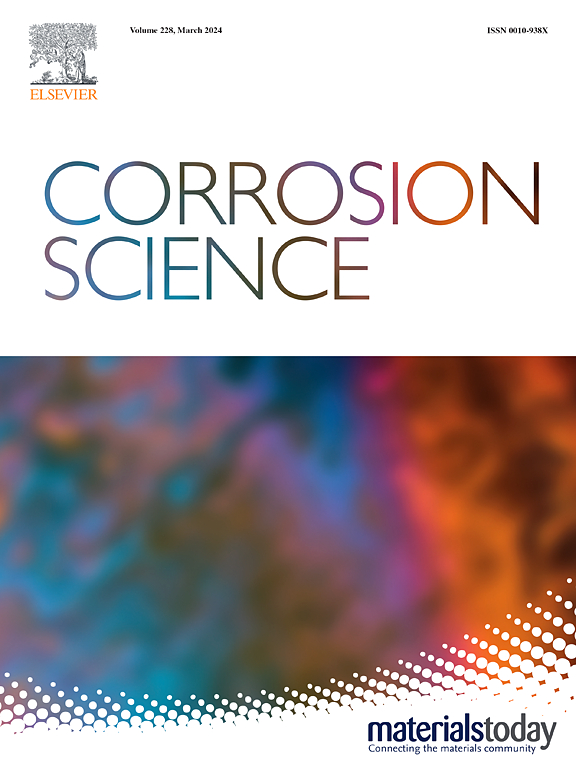硼酸三乙醇胺对工业层流冷却过程中热轧低碳钢耐腐蚀性能的影响
IF 7.4
1区 材料科学
Q1 MATERIALS SCIENCE, MULTIDISCIPLINARY
引用次数: 0
摘要
热轧生产中使用的层流冷却水氯离子浓度过高,会对钢材表面造成点蚀。本研究首次将生态友好且热稳定的有机缓蚀剂——硼酸三乙醇胺(TEA-B)作为该工艺的腐蚀控制添加剂。低碳钢样品在氯化钠含量为0.06 wt%和不同TEA-B浓度(0-5 wt%)的工业水环境中浸泡30天。通过电化学测试、表面表征和浸泡实验来评价其缓蚀性能和机理。结果表明,随着TEA-B浓度的增加,腐蚀速率显著降低,在TEA-B浓度为5 wt%时达到最大缓蚀效率88 %。XPS和KPFM分析证实,该缓蚀机制与BO3官能团在表面Fe原子上的化学吸附有关,这抑制了氯离子诱导的金属溶解和Fe2 + /Fe3+氧化物和Fe3+氢氧化物的形成。这些发现为减轻工业层流冷却过程中热轧钢中氯离子引起的腐蚀提供了一种有希望的策略。本文章由计算机程序翻译,如有差异,请以英文原文为准。
Effect of triethanolamine borate on corrosion resistance of hot-rolled mild steels in industrial laminar cooling processes
The high chloride ion concentration in laminar cooling water used during hot rolling production can cause pitting corrosion on steel surface. This study investigates triethanolamine borate (TEA-B), an eco-friendly and thermally stable organic inhibitor, for the first time as a corrosion control additive in this process. Mild steel samples were immersed in an industrial water environment containing 0.06 wt% sodium chloride content and different TEA-B concentrations (0–5 wt%) for 30 days. Electrochemical tests, surface characterisation, and immersion experiments were conducted to evaluate the inhibition performance and mechanism. The results revealed that the corrosion rate decreased significantly with increasing TEA-B concentration, reaching a maximum inhibition efficiency of 88 % at TEA-B concentration of 5 wt%. XPS and KPFM analyses confirmed that the corrosion inhibition mechanism is associated with the chemical adsorption of BO3 functional groups onto surface Fe atoms, which suppresses chloride ion-induced metal dissolution and the formation of Fe2 + /Fe3+ oxides and Fe3+ hydroxides. These findings provide a promising strategy for mitigating chloride ion-induced corrosion in hot-rolled steel during industrial laminar cooling processes.
求助全文
通过发布文献求助,成功后即可免费获取论文全文。
去求助
来源期刊

Corrosion Science
工程技术-材料科学:综合
CiteScore
13.60
自引率
18.10%
发文量
763
审稿时长
46 days
期刊介绍:
Corrosion occurrence and its practical control encompass a vast array of scientific knowledge. Corrosion Science endeavors to serve as the conduit for the exchange of ideas, developments, and research across all facets of this field, encompassing both metallic and non-metallic corrosion. The scope of this international journal is broad and inclusive. Published papers span from highly theoretical inquiries to essentially practical applications, covering diverse areas such as high-temperature oxidation, passivity, anodic oxidation, biochemical corrosion, stress corrosion cracking, and corrosion control mechanisms and methodologies.
This journal publishes original papers and critical reviews across the spectrum of pure and applied corrosion, material degradation, and surface science and engineering. It serves as a crucial link connecting metallurgists, materials scientists, and researchers investigating corrosion and degradation phenomena. Join us in advancing knowledge and understanding in the vital field of corrosion science.
 求助内容:
求助内容: 应助结果提醒方式:
应助结果提醒方式:


